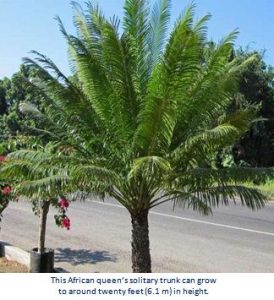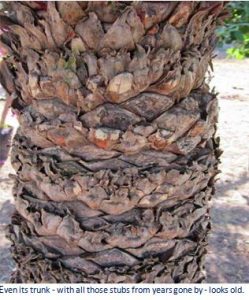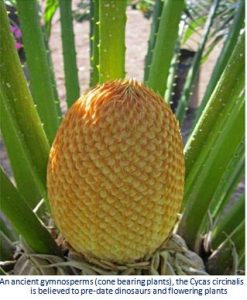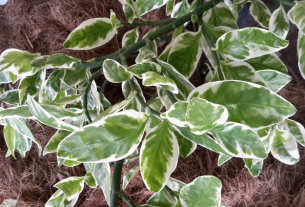By Tommy Clarkson from the October 2015 Edition
Queen Sago Palm (Cycas circinalis)
Family: Cycadaceae
Also known as: Queen Sago, False Sago or Fern Palm
Probably originating from the equatorial portion of the Dark Continent, this is another attractive palm imposter that, in actuality, is a cycad an ancient gymnosperms (cone bearing plants) believed to predate dinosaurs and flowering plans.
Like other cycads, with its featherlike leaves arranged in a rosette atop a single trunk it really does look rather like a palm tree, hence the confusion by many. As one might expect from a queen, it is a more graceful and actually larger than its much more commonly encountered cousin, the King Sago (Cycas revoluta) that originated in the Japanese islands of Ryuku and Satsuma, as well as Southern China. And, while she’s not one to lord it over the oriental King, this African queen’s solitary trunk can grow to more than twice the height of “his majesty’s” at twenty feet (6.1 m) in height. (Who says size doesn’t matter?)
 (Allow me to interject at this juncture that like so often happens in plant identification, a bit of confusion and conflict exists in that there are some botanists who feel that this cycad is actually a False Sago (Cycas rumphii) from Papua New Guinea, Indonesia.)
(Allow me to interject at this juncture that like so often happens in plant identification, a bit of confusion and conflict exists in that there are some botanists who feel that this cycad is actually a False Sago (Cycas rumphii) from Papua New Guinea, Indonesia.)
But I’m going with the designation of Queen Sago and that is just how ours is so identified on the Queen’s subterrace where “she” majestically holds court below some beautiful Queen’s Wreath Vines!
Its dark green, pinnate, leaves can grow up to eight feet (2.4 m) in length sporting, opposing narrow twelve inch (30.5 cm) leaflets that curve downward. When new, these leaves are light green and rather dramatically contrast with the older foliage.
Dieocious with male and female reproductive parts on separate plants these “cones” emerge in late winter from the center top of the plants. Nature then takes its course with the male cones’ pollen fertilizing the female cones. Later, the female plants produce large orange seeds in a cone appearing structure situated smack in the center of the leave’s rosette.
Tolerant of most soils, the Queen still prefers that of a loose and sandy nature with some organic matter and mulch we use coconut coir (husk fibers). Full sun to a moderate degree of shade are its preferred light conditions. Moisture-wise, the Cycas circinalis can take occasional, short-lived, periods of drought. But it really needs adequate moisture that must drain well if not beware of the dreaded root rot!
mulch we use coconut coir (husk fibers). Full sun to a moderate degree of shade are its preferred light conditions. Moisture-wise, the Cycas circinalis can take occasional, short-lived, periods of drought. But it really needs adequate moisture that must drain well if not beware of the dreaded root rot!
In older Queen Sago specimens some branching may occur, producing very handsome plants with multiple crowns.
Although the Queen Sago is a slow-grower it is easy to care for and a delightful addition to one’s garden what with the light textured tropical effect it adds. It can be situated as a featured specimen viewed from all sides or if space allows mass planted on eight to nineteen foot (2.4 – 9.7 meters) centers in large scale landscapes. It gets large so don’t make the mistake many do by planting it too close to a building or walkway.
It is susceptible to fungal disease and scale insects. For the former, treat with fungicide as necessary. Talk to your local plant chemicals professional about the best product for your area. Up north I know some use Orthene while our favorite’s Malathion around here. Alternate applications of it with horticultural oil and insecticidal soap solutions.
There are those who eat parts of this plant but I strongly urge one not to do so. It contains alkaloids of carcinogens as well as an amino-acid that can cause chronic nervous disorders, hence well, double duh! its consumption just durned near absolutely will lead to severe health problems or death. If that’s not reason enough, to eat parts of this plant will entail killing it and in that they are becoming rather rare in the wild, just think of yourself as a conservationist and decline Queen Sago as any manner of meal entrée or otherwise!
Beyond meals, some native folks use parts medicinally – and otherwise: The latter being that the pollen is a narcotic; the bark and the seeds can be ground to a paste with oil and used as a poultice to be placed on sores and swellings; the juice of tender leaves can be used in the treatment of flatulence and vomiting. Other than that next to the last thing, about which I might tell a radishes and cabbage munching, beer swilling pal, I vote we leave it alone medically too!
For back issues of “Roots”, gardening tips, tropical plant book reviews and videos of numerous, highly unique eco/ adventure/ nature tours, as well as memorable “Ultimate Experiences” such as Tropical Garden Brunches
Visit us at.. www.olabrisagardens.com
Download the full edition or view it online
—
Tommy Clarkson is a bit of a renaissance man. He’s lived and worked in locales as disparate as the 1.2 square mile island of Kwajalein to war-torn Iraq, from aboard he and Patty’s boat berthed out of Sea Bright, NJ to Thailand, Germany, Hawaii and Viet Nam; He’s taught classes and courses on creative writing and mass communications from the elementary grades to graduate level; He’s spoken to a wide array of meetings, conferences and assemblages on topics as varied as Buddhism, strategic marketing and tropical plants; In the latter category he and Patty’s recently book, “The Civilized Jungle” – written for the lay gardener – has been heralded as “the best tropical plant book in the last ten years”; And, according to Trip Advisor, their spectacular tropical creation – Ola Brisa Gardens – is the “Number One Tour destination in Manzanillo”.




You must be logged in to post a comment.